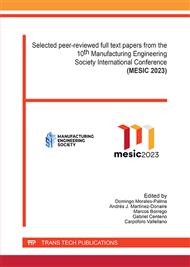[1]
S. Pattanayak y S. K. Sahoo, «Gas metal arc welding based additive manufacturing—a review», CIRP Journal of Manufacturing Science and Technology, vol. 33, pp.398-442, may 2021.
DOI: 10.1016/j.cirpj.2021.04.010
Google Scholar
[2]
P. K. Palani y N. Murugan, «Optimization of weld bead geometry for stainless steel claddings deposited by FCAW», Journal of Materials Processing Technology, vol. 190, n.o 1, pp.291-299, jul. 2007.
DOI: 10.1016/j.jmatprotec.2007.02.035
Google Scholar
[3]
C. V. Gonçalves, L. O. Vilarinho, A. Scotti, y G. Guimarães, «Estimation of heat source and thermal efficiency in GTAW process by using inverse techniques», Journal of Materials Processing Technology, vol. 172, n.o 1, pp.42-51, feb. 2006.
DOI: 10.1016/j.jmatprotec.2005.08.010
Google Scholar
[4]
M. M. Mahapatra, G. L. Datta, B. Pradhan, y N. R. Mandal, «Three-dimensional finite element analysis to predict the effects of SAW process parameters on temperature distribution and angular distortions in single-pass butt joints with top and bottom reinforcements», International Journal of Pressure Vessels and Piping, vol. 83, n.o 10, pp.721-729, oct. 2006.
DOI: 10.1016/j.ijpvp.2006.07.011
Google Scholar
[5]
J. A. Girón-Cruz, J. E. Pinto-Lopera, y S. C. A. Alfaro, «Weld bead geometry real-time control in gas metal arc welding processes using intelligent systems», Int J Adv Manuf Technol, vol. 123, n.o 11, pp.3871-3884, dic. 2022.
DOI: 10.1007/s00170-022-10384-z
Google Scholar
[6]
E. Aldalur, A. Suárez, y F. Veiga, «Metal transfer modes for Wire Arc Additive Manufacturing Al-Mg alloys: Influence of heat input in microstructure and porosity», Journal of Materials Processing Technology, vol. 297, 2021.
DOI: 10.1016/j.jmatprotec.2021.117271
Google Scholar
[7]
E. A. Gyasi, P. Kah, S. Penttilä, J. Ratava, H. Handroos, y L. Sanbao, «Digitalized automated welding systems for weld quality predictions and reliability», Procedia Manufacturing, vol. 38, pp.133-141, ene. 2019.
DOI: 10.1016/j.promfg.2020.01.018
Google Scholar
[8]
E. A. Gyasi, P. Kah, S. Penttilä, J. Ratava, H. Handroos, y L. Sanbao, «Digitalized automated welding systems for weld quality predictions and reliability», Procedia Manufacturing, vol. 38, pp.133-141, ene. 2019.
DOI: 10.1016/j.promfg.2020.01.018
Google Scholar
[9]
J. Mirapeix, A. Cobo, D. A. González, y J. M. López-Higuera, «Plasma spectroscopy analysis technique based on optimization algorithms and spectral synthesis for arc-welding quality assurance», Optics Express, vol. 15, n.o 4, pp.1884-1897, 2007.
DOI: 10.1364/OE.15.001884
Google Scholar
[10]
G. A. Bestard, R. C. Sampaio, J. A. R. Vargas, y S. C. A. Alfaro, «Sensor Fusion to Estimate the Depth and Width of the Weld Bead in Real Time in GMAW Processes», Sensors, vol. 18, n.o 4, Art. n.o 4, abr. 2018.
DOI: 10.3390/s18040962
Google Scholar
[11]
P. Kah, M. Shrestha, E. Hiltunen, y J. Martikainen, «Robotic arc welding sensors and programming in industrial applications», International Journal of Mechanical and Materials Engineering, vol. 10, n.o 1, p.13, jul. 2015.
DOI: 10.1186/s40712-015-0042-y
Google Scholar
[12]
K. C. Tsao y C. S. Wu, «Modelling the three-dimensional fluid flow and heat transfer in a moving weld pool», Engineering Computations, vol. 7, n.o 3, pp.241-248, 1990.
DOI: 10.1108/eb023811
Google Scholar
[13]
S. Chen, T. Sun, X. Jiang, J. Qi, y R. Zeng, «Online monitoring and evaluation of the weld quality of resistance spot welded titanium alloy», Journal of Manufacturing Processes, vol. 23, pp.183-191, ago. 2016.
DOI: 10.1016/j.jmapro.2016.06.003
Google Scholar
[14]
Y. Liu, J. Liu, y X. Tian, «An approach to the path planning of intersecting pipes weld seam with the welding robot based on non-ideal models», Robotics and Computer-Integrated Manufacturing, vol. 55, pp.96-108, feb. 2019.
DOI: 10.1016/j.rcim.2018.07.010
Google Scholar
[15]
J. Zeng et al., «A Weld Position Recognition Method Based on Directional and Structured Light Information Fusion in Multi-Layer/Multi-Pass Welding», Sensors, vol. 18, n.o 1, Art. n.o 1, ene. 2018.
DOI: 10.3390/s18010129
Google Scholar
[16]
S. M. Ahmed, J. Yuan, Y. Wu, C. M. Chew, y C. K. Pang, «Collision-free path planning for multi-pass robotic welding», en 2015 IEEE 20th Conference on Emerging Technologies & Factory Automation (ETFA), sep. 2015, pp.1-4.
DOI: 10.1109/etfa.2015.7301594
Google Scholar
[17]
F. Veiga, A. Suarez, E. Aldalur, y T. Artaza, «Wire arc additive manufacturing of invar parts: Bead geometry and melt pool monitoring», Measurement, vol. 189, p.110452, feb. 2022.
DOI: 10.1016/j.measurement.2021.110452
Google Scholar



